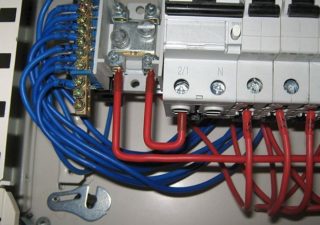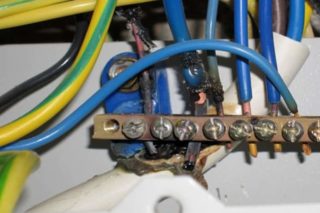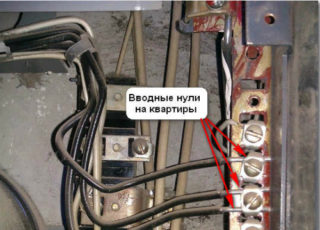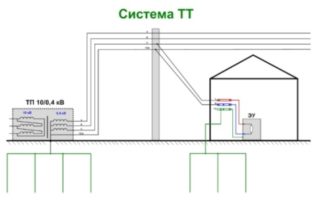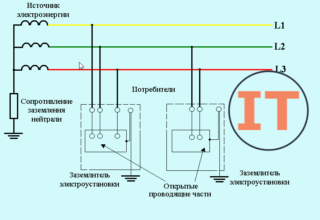To equalize the voltage across the phases of electrical installations, a neutral wire is used. It is necessary to prevent ignition of appliances and fires. The cable is part of the neutral - the common point of the generator or transformer winding, connected like a star. There are two types of conductor - working N and protective PE.
What is a neutral wire
When working with electricity, it is important to understand what a working and protective neutral wire is. In the first case, it equalizes the voltage in phase, in the second - it protects the grounding. Users mistakenly believe that the neutral conductor is exclusively ground. Its main function is to connect the neutrals of the installations in a three-phase circuit.
When a different load is applied to each phase, a neutral shift occurs - the symmetry of the stresses is violated. Some consumers are supplied with increased voltage, while others receive reduced voltage. At low voltage, electrical appliances malfunction, at high voltage they are overloaded and light up. The task of zero is to equalize the increased and decreased indicators, ensuring the balance of the power grid.
The PUE has a zero wire color - blue, which meets European standards.
Principle of operation
In new buildings and houses of the old buildings, the energy transfer scheme is fundamentally different. The electrical network of new buildings is designed according to the principle of TN-S:
- electricity comes from transformers with a secondary winding connected in the form of a "star" (wires converging at zero point);
- the second part of the cable ends is led to terminals A, B, C, also connected at the zero point, and connected to the substation along the grounding circuit;
- the high-voltage wire with zero resistance is divided into protective PE (yellow-green) and working N (blue).
In the general switchboard of a new building, 3 phases, a protective conductor and a neutral wire are brought.
 Old houses do not have protective wiring. An outdated four-wire TN-C system is implemented there:
Old houses do not have protective wiring. An outdated four-wire TN-C system is implemented there:
- zero grounded conductor located in the junction box;
- phase and zero from the transformer are thrown to the building through underground or above-ground high-voltage cables;
- the wires are connected in the input shield, forming a three-phase system with an operating voltage of 220 or 380 V;
- from the dashboard, wiring to apartments and entrances is performed;
- consumers get electricity from the wires of one of the phases through a network with a voltage of 220 V;
- the difference in load is eliminated by supplying a zero N-wire.
Wiring diagrams of old houses for electricity are outdated and unsafe.
Operating modes
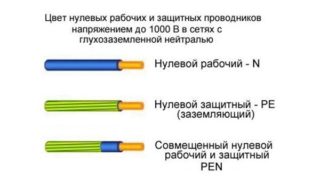 The following neutral modes of electrical networks:
The following neutral modes of electrical networks:
- solidly earthed (380 volt – 110 kilovolt networks) - neutral and earth potentials are the same;
- isolated (networks of 6, 10 and 35 kilovolts) - between the neutral and the ground there are slight current leaks;
- part of the mains with a small impedance of resistance and earth resistance.
A neutral wire is used to prevent emergency voltage surges in phase, for the purpose of relay protection against phase short circuits to earth, as well as to ensure the reliability of electrical appliances.
What is dangerous damage to the neutral wire
Zero is damaged due to mechanical stress, short circuits, poor connection or as a result of old wiring. Neutral break:
- PEN conductor in the power cable - there remains one ground loop, which is not visually noticeable;
- combustion of the conductor in the switchboard - phase conductors are warped, the voltage indicator increases to 380 V;
- break in the panel of the apartment - the second phase remains in the sockets, household appliances are not powered from them.
Damage to the neutral eliminates the equal potentials of networks with different loads, as a result of which household appliances can burn out. Insulation in such cases breaks through. In an old housing estate with a TN-C connection diagram (zero - protective conductor), there is a risk of electric shock during breakdowns. In new buildings, damage to zero leads to the fact that when you touch the technique, light current discharges are felt.
Discharges of current from touching the equipment case also indicate its malfunction.
The reaction of electrical appliances to a zero break
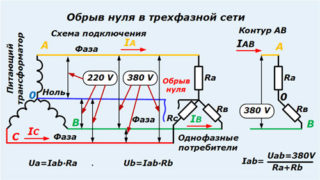 If zero breaks per phase with a large number of consumers, the load increases. The voltage is reduced. In the phase with fewer consumers, there is a sharp increase in voltage. Electrical appliances can:
If zero breaks per phase with a large number of consumers, the load increases. The voltage is reduced. In the phase with fewer consumers, there is a sharp increase in voltage. Electrical appliances can:
- to work with failures;
- break or burn when connected to the network;
- be shocked if grounding is not performed.
A consequence of neutral damage is the failure of expensive equipment with sensitivity to network fluctuations. To eliminate electrical hazards, it is required to put an individual shield with a voltage limiter. In case of differences, it will quickly turn off the power.
Tasks and purpose of the neutral wire
The mounting role of the core neutral wire is the connection of the null elements of electrical installations to the neutral earth. In fact, it equalizes the potential difference of the phases, diverts currents from areas with wiring closure, prevents injuries and evenly distributes the load across all apartments.
A star-type eyeliner system has vector indicators identical to a transformer substation. The connection is reliable, but only subject to the quality of the wires and compliance with the rules for their connection.
Re-grounding
Re-grounding of the neutral conductor is the protection installed on the intervals defined by the rules of the PUE throughout the entire length of the neutral. The tasks of re-grounding include reducing the voltage in the neutral wire and electrical appliances that were zeroed relative to the ground. This property is advisable as a protection against the breakage of the neutral wire and during the breakdown of electrical voltage to the body of electrical appliances.
To make a reconnection, it is necessary to conduct a continuous neutral from the shield to the neutral conductors. In conditions of high-rise buildings for re-grounding, various systems are used.
TN
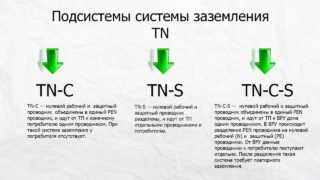 The transformer neutral in the electrician is grounded, and the accessible part is connected to it through zero protective conductors. In normal mode, the power receiver is not energized. TN system happens:
The transformer neutral in the electrician is grounded, and the accessible part is connected to it through zero protective conductors. In normal mode, the power receiver is not energized. TN system happens:
- TN-S - protective and neutral conductor are separated by the length of the entire line;
- TN-C-S - the functions of the PE and N wires are combined in one part of the conductor removed from the transformer.
If communications are connected in a private house, natural grounding conductors are used - metal pins in the ground. Regulatory documents do not recommend the use of natural conductors, since it is impossible to calculate the resistance that the soil gives when current spreads.
TN-C
Grounding in houses built before the mid-90s, for which the four-wire method was used - 3 phases and 1 zero. The protective and working functions of the neutral are performed by a common conductor throughout the entire line. Consumer power comes from the PEN cable. It is also used for grounding.
TT
It is used to supply electricity in rural and rural conditions. Current flows through power lines on poles.Installations are allowed in cases where TN is impossible or very expensive. When applying an increased current to the devices, the power circuit is completely turned off through the RCD.
IT
Mains with transformer isolated neutral. It is diverted from the ground or grounded through a receiver with high resistance. The ground line is drawn on a separate bus, and the contacts of the sockets are already connected on it. The organization of the system is suitable for educational, medical institutions.
What is grounding and neutral wire
 The function of the neutral conductor N is the balance of potentials of several phases and providing consumers with current. The neutral wire is connected to the transformer neutral earthed neutral. In private homes, a single-phase type of connection using a zero and phase cable is used. A ground loop is used to connect ground to ground. The neutral itself is marked with blue insulation.
The function of the neutral conductor N is the balance of potentials of several phases and providing consumers with current. The neutral wire is connected to the transformer neutral earthed neutral. In private homes, a single-phase type of connection using a zero and phase cable is used. A ground loop is used to connect ground to ground. The neutral itself is marked with blue insulation.
The ground conductor ensures the safety of the power line in the event of a breakdown. Its normal mode of operation is wired; during critical failures, the current potential is diverted to the soil. The PE cable is marked with a blue-yellow color.
The neutral and protection in one wire are marked PEN, marked in blue with yellow and green stripes at the ends.
Wiring diagram for neutral wire and ground
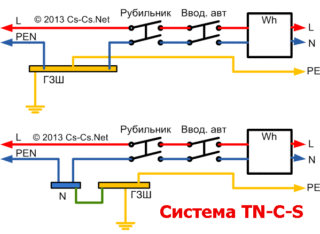 In IEC-364, GOST 30331.1-95, there are schemes for connecting a network, the load of which is 380 volts. For this reason, it is recommended to use one of the systems in the apartment.
In IEC-364, GOST 30331.1-95, there are schemes for connecting a network, the load of which is 380 volts. For this reason, it is recommended to use one of the systems in the apartment.
Separate grounding line TN-CS.The neutral shields and protective conductors of the home switch are connected to each other. If there are two wires, the PEN cable at a certain point is divided into neutral and protection. PE wires snap to N. conductors. The circuit protection depends on the break point:
- To the place of separation. The phase conductor and the wired device divert the voltage to the neutral, and from it to the protection wire.
- After the place of separation. Dangerous electricity is not transmitted to the housing of household appliances, but is immediately transferred to the protection wire.
In high-rise buildings, it is not always possible to make such a grounding line.
Separate grounding circuit TN-S.The network is earthed at the neutral transformer point, from where the wiring is output to the devices. Three-phase apartment network with a fully insulated neutral wire is the most protected from failures. A zero conductor damaged in any area does not interact with the protective conductor, therefore, it has no risks to human health. The only problem is the temporary shutdown of the equipment.
Rules for connecting neutral
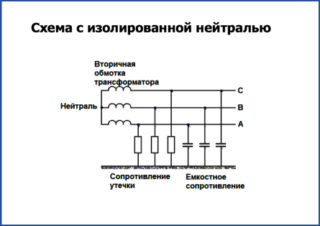 Chapter 1.7 of the PUE addresses in detail electrical safety during grounding. The Bible of the electrician says:
Chapter 1.7 of the PUE addresses in detail electrical safety during grounding. The Bible of the electrician says:
- for electrical installations with a voltage of more than 1 kV, a grounded neutral is required, which removes large fault currents to the ground;
- for equipment up to 1 V, an isolated or dead neutral can be used;
- dead-grounded neutral must be zeroed and connected to the ground line through a transformer;
- grounding and neutral are carried out using copper (cross-section 4 mm2), aluminum (cross-section 6 mm2), insulated (1.5 mm2 and 2.5 mm2) cables;
- copper cables connected in one bundle must have a cross section of 1 mm2, from aluminum - 2.5 mm2;
- if 3 wires are pulled from the dashboard of an apartment or floor, a protective neutral is used;
- if the group network is performed using two cables, the protection neutral is extended from the near shield;
- all home appliances are connected to zero - a kettle, air conditioning, a computer, a washing machine, a boiler, a refrigerator.
Provided that the connection diagram is correct, a protective neutral wire can prevent damage to the power supply and personal injury in the event of a short circuit. Neutral evenly distributes the load across all lines, floors and apartments of a multi-story building. With its initial and repeated connection, it is worth being guided by the PUE.
